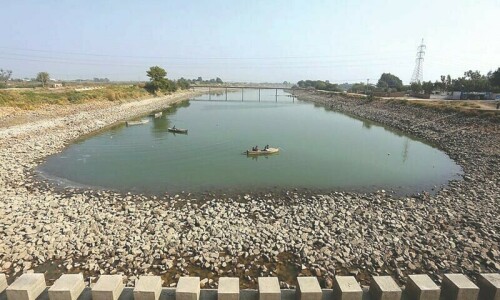ISLAMABAD: The government on Friday expressed concern over below-normal rainfall, which could make it difficult to meet the Rabi crop output targets.
The Ministry of Finance, in its Monthly Economic Update and Outlook for December, acknowledged the importance of supporting farmers to achieve agricultural output targets, which are critical for reaching the overall economic goals for FY25 and sustaining economic recovery.
The government highlighted the potential challenges posed by weather conditions, particularly below-normal rainfall, which may lead to water stress during the crucial emerging stage of Rabi crops such as wheat and barley, particularly in rain-fed agricultural zones.
The government forecasts GDP growth of 3.6 per cent for FY25, while the State Bank of Pakistan has projected growth in the range of 2.5pc to 3.5pc. The World Bank, however, anticipates a 2.8pc expansion in GDP for FY25. Despite challenges in some sectors, there is optimism that the government can achieve its GDP growth target, as industrial output shows signs of improvement, exports continue their growth momentum, and remittances have increased.
Despite challenges in some sectors, govt may achieve GDP growth target
On the industrial front, while certain sectors remain in negative territory, the economy’s resilience is demonstrated by the strong performance of high-weighted sectors, which continue to drive Large-Scale Manufacturing (LSM) in October. Both the automobile and cement sectors exhibited robust performance in November, providing a much-needed boost to allied industries. The finance ministry emphasised that the ripple effect and interconnectedness of industrial sectors could reinforce broader economic growth.
Furthermore, the recent easing of monetary policy in December is expected to stimulate economic activity. The increasing demand for credit, particularly from the private sector, is a positive sign of growing confidence in the economy. This momentum is expected to accelerate, fostering higher production levels and enhanced economic output in the coming months.
On the agriculture side, the government has set a wheat production target of 27.92 million tonnes for Rabi 2024-25, to be harvested from an area of 9.26m hectares. To achieve this, efforts are under way to ensure the timely availability of essential farm inputs, including agricultural credit, quality seeds, fertilisers, and mechanisation support.
Agricultural credit disbursement for July-November FY2025 reached Rs925.7 billion, an 8.5pc increase compared to Rs853bn during the same period last year. This positive trend is expected to continue, aligning with the ambitious agriculture credit target of Rs2.572 trillion for FY25. The increase in agricultural machinery sales, as well as higher urea and DAP offtake, further signals sectoral growth. The rise in DAP offtake is attributed to the Punjab government’s initiative of providing interest-free loans to small farmers through the Kissan Card Programme for the purchase of agricultural inputs such as seeds and fertilisers.
Externally, stability is expected to continue, supported by remittances and export inflows, while imports remain manageable. Exchange rate stability and controlled inflation, forecast to stay within the 4-5pc range for December 2024, are expected to complement this stability. The government also expects its improved fiscal performance during July-October, driven by higher revenues and prudent expenditure management, to create fiscal space for development spending and support sustainable economic growth.
Global commodity prices, however, have shown mixed trends. Energy prices decreased by 1.2pc in November, driven by a 4.7pc decline in natural gas prices and a 3.1pc drop in coal prices. Non-energy prices saw little change. Fertiliser prices dropped by 3pc, while meal prices contracted by 3.1pc.
The FAO Food Price Index (FFPI) averaged 127.5 points in November 2024, a 0.5pc increase from October, reaching its highest value since April 2023. This rise was driven by higher prices for dairy products and vegetable oils, which outweighed declines in meat, cereals, and sugar prices. Compared to historical levels, the FFPI in November was 5.7pc higher than the corresponding value a year ago, but still 20.4pc below its peak of 160.2 points reached in March 2022.
Published in Dawn, December 28th, 2024














































